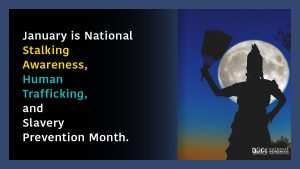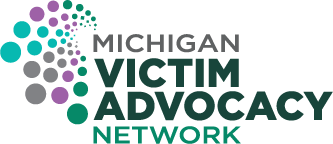January is National Stalking Awareness, Human Trafficking, and Slavery Prevention Month
January 2022
Newsletter from National Indigenous Women’s Resource Center

“The National Indigenous Women’s Resource Center (NIWRC) uplifts the tireless work of Native advocates and programs as we work together to shine a light on January as National Stalking Awareness, Human Trafficking, and Slavery Prevention Month. As a national Native-led nonprofit organization dedicated to ending violence against Indigenous women and children, NIWRC strongly supports the efforts to raise awareness of and action to end these crimes, given American Indians, Alaska Natives, and Native Hawaiians experience some of the highest rates of sex trafficking and stalking in the United States.
Indigenous groups in the U.S. – including American Indians, Alaska Natives, and Native Hawaiians – are especially at risk for targeting by traffickers.1 American Indians and Alaska Natives are also disproportionately affected by stalking, where 1 out of 2 Native women and 1 out of 10 Native men are stalked in their lifetime.2 Native LGBTQ and Two-Spirit people experience higher poverty and homelessness rates, making this community more vulnerable to stalking and trafficking.3
At NIWRC, a critical component of our work involves lifting up the voices of Tribal Nations and grassroots advocates in the call for safety, sovereignty, and justice for victims of trafficking and stalking in their communities. We provide support in raising awareness of crimes alongside Native advocates in addition to offering technical assistance and training, resources, and policy development specific to these issues. We will continue to center the experiences of Native survivors of violence and support the sovereign rights of Indigenous Nations to increase safety for their citizens to prevent future acts of violence against Indigenous women and children.
Find information and resources on stalking and human trafficking below, and visit NIWRC’s social media pages in January for sharable information to support survivors in our communities.
What is stalking?
Stalking is a pattern of unwanted behaviors that violate your privacy, making you feel threatened, in danger, or scared. Stalking behaviors can include, but are not limited to:
- Following, watching, or driving by where you are
- Making repeated calls, texts, or messages
- Sending unwanted gifts or letters
- Getting information about you through family, relatives, your garbage
- Other intimidating, controlling, or invasive behaviors
What is Cyberstalking?
Cyberstalking is the misuse of the Internet or other technology to stalk and harass someone.4 For stalkers, the Internet can be a prime place for gender-based violence. Cyberstalking behaviors can include, but are not limited to:
- Hacking a camera on your phone or computer to watch you or view your surroundings
- Monitoring your computer, social media accounts, calls, or texts
- Using GPS or apps to view your surroundings, track your location, or monitor your actions online
- Sharing your personal information, images, or videos without consent to hurt or expose you5
Stalking is often a part of gender-based violence6 and can cause fear, sleep problems, or depression. Stalking is unpredictable and dangerous because no two stalking situations are alike.
If you’re being stalked, there are steps you can take to increase your awareness and safety:
- Know that it’s never your fault.
- Never approach or respond to a stalker or attempt to deal with the situation by yourself–get help immediately from law enforcement, a domestic violence program, and/or trusted family and friends.
- Take all threats seriously, especially if there is talk of suicide or murder, or if you’re trying to leave or end a relationship.
- If you feel unsafe, stay with family or friends or in a domestic violence shelter.
- Do not travel alone; change your routine and travel routes, if you can.
- Document everything that happens with time and dates, save texts, record phone calls, keep unwanted “gifts,” etc.
- Call the police and ask for written reports of all incidents.
- Contact the police to request a protection or restraining order.
- Protect your privacy online by creating strong passwords for all your devices and accounts, including social media, and cover your computer camera with a piece of tape.
What is Human Trafficking?
Human trafficking is a crime involving the use of force, fraud, or coercion to compel a person to perform some type of labor or commercial sex. Trafficking can happen in any community and anyone can be trafficked, regardless of age, race, gender, nationality, or socioeconomic status. Native populations experience disproportionately high rates given the history of government-sanctioned policies that resulted in being trafficked in boarding schools and by child welfare systems, churches, the military, and extractive industries. Traffickers often use violence, physical and psychological torture, manipulation, and/or false promises of well-paying jobs or romantic relationships to entrap victims into trafficking situations.
Another type of human trafficking is sex trafficking, which involves the recruitment, harboring, transportation, provision, or obtaining of a person for commercial sex, in which sexual acts are induced by force, fraud, or coercion, or in which the person induced to perform such act has not attained 18 years of age. Traffickers may use technology to target their victims. In the United States, 40% of victims are recruited online, frequently through means such as false job postings and social media.7
Victims of sex trafficking are often isolated, “invisible” to society, labeled as “throwaway kids”, addicts, or are targeted because they are already vulnerable. It’s important to note that traffickers can be part of a gang, organized crime syndicate, a family member/relative, or a supposed friend, boyfriend, or spouse.
Signs that someone might be trafficked can look like but are not limited to when a person:
- Is fearful and mistrusting
- Cannot buy their own food or clothes
- Is malnourished
- Has no contact with relatives or friends
- Cannot travel/move about independently
- Is prevented from getting medical attention, and/or is accompanied during medical care visits
- Has scarring, cigarette burns, or tattoos/branding
- Shows signs of substance abuse or addiction
- Has traumatic brain injury
- Has post-traumatic stress disorder (PTSD), is anxious or depressed
If you or someone you know is being trafficked, there are resources to help:
- Remember trafficking is never the victim’s fault.
- Call local police if you or the victim are in danger.
- StrongHearts Native Helpline 1-844-7NATIVE (762-8483) is a 24/7 safe, confidential and anonymous domestic, dating, and sexual violence helpline for Native Americans and Alaska Natives, offering culturally-appropriate support and advocacy. Visit strongheartshelpline.org and click on the “Chat Now” icon to connect one-on-one with a live advocate.
- Reach out to your local domestic violence or sexual violence program, or contact the National Human Trafficking Hotline at 1-888-373-7888 or text “BeFree” to 233733.
- To report suspected human trafficking to federal authorities, contact the U.S. Department of Homeland Security at 1-888-347-2423.
Helpful Resources:
- Wear blue to raise awareness of human trafficking on January 11th for National Human Trafficking Awareness Day. Post a photo on social media using the hashtag #WearBlueDay.
- Share Stalking and Trafficking awareness cards from our Facebook, Instagram, and Twitter pages in January.
- Learn more about stalking by StrongHearts Native Helpline and the Coalition to Stop Violence Against Native Women.
- Explore resources by the Stalking Resource Center.
- Explore trafficking resources:
- Human Trafficking Leadership Academy Class 5 Recommendations Report to learn more about the historical context of trafficking and its continued impacts on Indigenous communities today.
- National Training and Technical Assistance Project on Sex Trafficking in Indian Country and Alaska by the Minnesota Indian Women’s Sexual Assault Coalition.
- Sex Trafficking in Indian Country: Advocacy Curriculum, designed to introduce information on sex trafficking of Native people.
- Garden of Truth: The Prostitution and Trafficking of Native Women in Minnesota.
- Tribal Sex Trafficking Resources Website by the Tribal Law & Policy Institute.
- Native Youth Toolkit on Human Trafficking by the Administration for Native Americans.
- SOAR for Native Communities module on human trafficking.
- Recognizing Sex Trafficking by the Polaris Project.
- Find resources on trafficking and exploitation by the National Sexual Violence Resource Center.
- Blue Campaign by the U.S. Department of Homeland Security.
About the National Indigenous Women’s Resource Center:
The National Indigenous Women’s Resource Center, Inc. (NIWRC) is a Native-led nonprofit organization dedicated to ending violence against Native women and children. NIWRC provides national leadership in ending gender-based violence in tribal communities by lifting up the collective voices of grassroots advocates and offering culturally grounded resources, technical assistance and training, and policy development to strengthen tribal sovereignty. niwrc.org
This statement can be found online here.”
